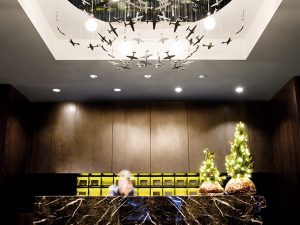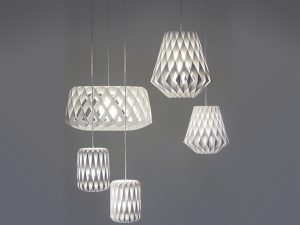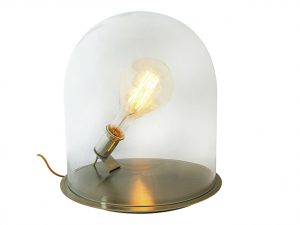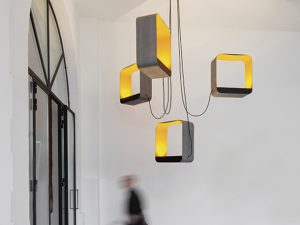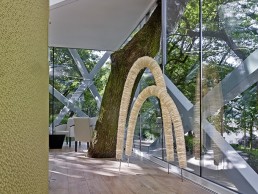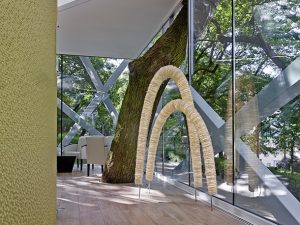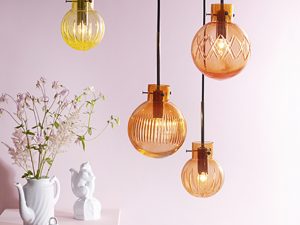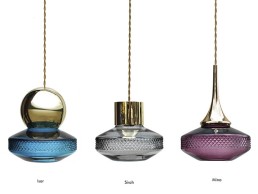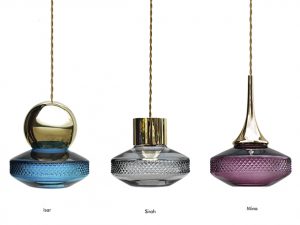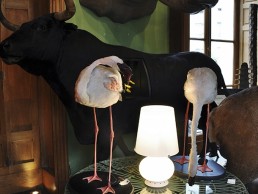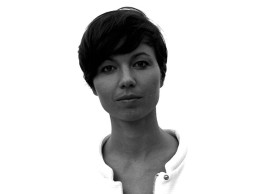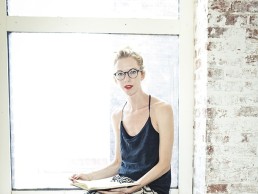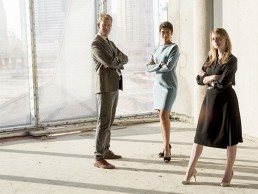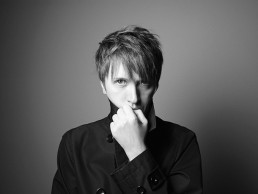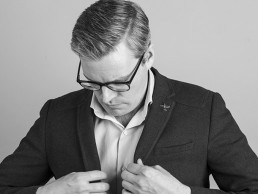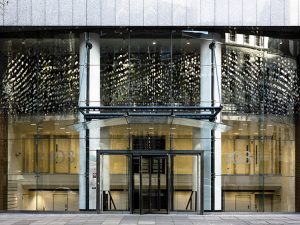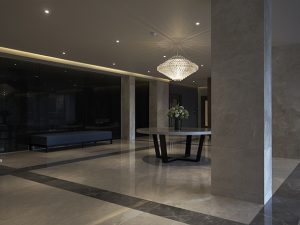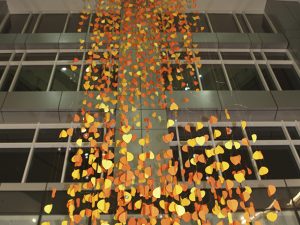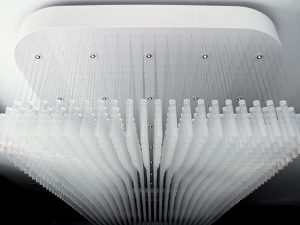PILKE
The PILKE plywood lamp family consists of five pendant lamps in three colour options. It is also available as a table lamp and floor lighting. Assembled by numerous plywood parts in a way that brings together traditional Finnish handcraft techniques and ultramodern computer geometry. No glue or screws are needed.
Glow in a Dome XL
Glow in a Dome XL - a new floor lamp by Ebb & Flow measures 50cm in both height and diameter and features a brushed metal base and mount. The hand-blown glass dome is a true testament to the craftsmanship of the glass blowers and factories that produce Ebb & Flow’s lights.
Eau de lumière
Created for Designheure by Davide Oppizzi, these lamps, wall lamps and chandeliers symbolise the luxury perfume bottle playing on full volume and hairlines on which reflect light. Masculine and feminine forms, curves and angles offer a diverse collection with a strong personality.
Arc
Arc is inspired by the arcades of Santiago de Compostera, composed by two crossed arches. Its strength is channelled along the interior LED light that escapes through the recycled Japanese cord, wrapping it in a mysterious dignity.
Krystallkule
Designed by Maud Gjeruldsen Bugge, each pendant combines traditional mouth-blown glass-production techniques with the craft of crystal cutting by hand, creating a minimalist modern shape with an ornate, nostalgic pattern. The lamps are made to order, and available in four patterns, various colours and three sizes.
Mina, Sirah & Isar
This new trio of jewel-like pendant lights is an elegant contemporary blend of Eastern style and English cut crystal. Individually made from hand cast highly polished brass sections, juxtaposed with coloured mouth blown crystal shades. To be hung individually, or as a group.
FontanaArte at Deyrolle, France
Representing life in various forms, Deyrolle temple of taxidermy in Paris housed FontanaArte's floor, table, wall, and suspension lamps from its 2015 Collection and historical archive; nestled amongst an encapsulating array of hauntingly real animals, the unlikely combination created an experience of life for its visitors with FontanaArte's 'lights to live'.
The Italian design team showcased a range of products including some of the brand's most representative icons, together with a selection of new-generation lamps, for use in the contract sector and in homes. The historical and modern designs on show, set against the rich backdrop provided by Deyrolle presented the brand in an innovative light, standing out as a highlight; a spectacular part of Paris Design Week where creativity is displayed at its highest height. The display featured a number of the brand’s traditional designs, such as famous Italian architect, interior and product designer Gae Auleti’s Giova table lamp, which marked her debut in the field of designer lighting in 1964. These traditional pieces have provided inspiration for FontanaArte’s newest releases, such as those designs found in its 2015 Collection.
A collaborative approach with designers of different backgrounds and varying experiences is a characteristic element of FontanaArte. This display saw designers such as Karim Rashid, Carlo Colombo and Claesson Koivisto to name a few standing out next to stuffed tigers, bears and tiny chicks. Through this exhibition, FontanaArte made movements towards the brand image makeover it has desired with the release of its new website and publication of the FontanaArte Book, a volume giving readers a closer look at design products and projects from across the globe. Further to this, guests were given the FontanaArte magazine, a special edition illustrating the 2015 Collection and activities the designer has been involved in this year.
Design by Mai
After growing up in Ghent, Belgium and a lifetime full of travel, Mai Waelkens returned home, which she considers “a small treasure to live in”. It’s in this same town that she once studied interior design at the Sint-Lucas Institute where she received a degree in Interior Design in 2007. Following graduation, Waelkens was given the opportunity to do an internship in Capetown, South Africa where she was able to conceptualise interior designs, furniture and lamps for clients with lofts, houses, hotels and apartments. Upon returning to Belgium, she felt ready to become an independent entrepreneur.
“After founding my own design company, for the next seven years I designed interiors,” Waelkens tells darc. “I wanted to be involved in every step of the process, personally coordinating each construction site myself in close collaboration with a team of experienced contractors. Working on construction floors taught me the link between my idea and the realisation of it.”
Interior architecture was just the beginning for Waelkens. “For me, there has always been something else as appealing as cool architecture; I have a craving to design products, foremost lighting products. It’s something I’m drawn into. One day I took a deep breath and I jumped.”
What Waelkens calls an “unmasterable desire” to create resulted in her first series of carefully crafted design products, known as the Carve Your World collection: consisting of lamps, lounge chairs, flower pots and sculptures. For months and months - for some products it took years - she travelled and researched, contacting craftsmen and factories in an attempt to find the right people.
During her travels, Waelkens found herself in Milan and launched into the life of a fashion designer. However the Marangoni Fashion & Design Institute wasn’t suited to her ambition.
After extensive research and cultural exploration, Waelkens returned to Ghent ready to create. Citing her inspirations she makes her fondness for Ingo Maurer, Ross Lovegrove and Ron Arad apparent but explains that she is “more of an observer - I’m fascinated by people and how their environments influence them”.
She continues: “The conditioned way in which humans think is often something I chew on. We all should be rebels instead of robots. Contemplating on all of that fills my heart and soul and my brain with more than enough inspiration to just try to do what I do... create things of beauty.”
With this mantra in mind, the slogan of her very first collection encapsulates her ‘true self’, with inspiration coming from nature. “There’s no better field of art than that.” Waelkens continues, “Not just the colours or the laws of nature, but the simplicity of it. The way nature functions, seemingly effortless. When it’s silent in my head I can make the crystallisation of all of that.”
The Belgium-based designer also notes that for her light is emotion. “The way light breaks, drops or just floats in a room can keep me busy for hours. Light is the kind of phenomenon that reaches an almost palpable level, changing mood, mind and inner feelings. Whether it’s just an accent, emphasis or soft and muted, the ricochets of light never fail to touch, inspire and move me.”
Ahead of releasing her first collection, Waelkens had worked for six months to create two different models of lamps - Skybeamer and Grid. On top of this she presented a loungechair and her version of a design flower pot. “Seeing hundreds of people walking by, touching the stuff I’d come up with, hearing their comments made it clear for me that I wanted to design,” she tells darc.
As it is widely acknowledged, in only 20 years time, a revolution has taken place; LED and the miniaturisation of electronic components. In light of this, Waelkens believes that...“in the future, there will be (even) more interaction between object and space because of all the new tricks designers can use. On top of that, new materials are in sync with organic shapes that used to be only conceptual. Chemical melting points can be pushed so that coagulation can be manipulated, resulting in the creation of wild shapes that you could previously only dream of. Tomorrow, the sky will be limitless. I hope that these new technologies will make design simpler and bring the essence of things to the foreground.”
Waelkens continues to be driven in her conquest of design, requiring a particular way of thinking. “Every lamp I make has a twist of movement, a playfulness or joy. I reach that place only through turbulent processing. I experiment, stumble and fall. In that subtle balance between harmony and curiosity, organic designs, sculptures, concepts and light are born. I try to make a connection with people through my designs.”
Often, at the birth of Waelkens’ intensive design process is the imagination that “if the sun would cease to shine, the only thing pounding in my eyes would be the memory of light, the essence of life”.
Bec Brittain
Born into a family of architects, painters and furniture makers, a career path in design was something of a natural progression for Brooklyn-based lighting designer Bec Brittain. Having grown up in Washington DC, “as part of a rare non-government associated family”, Brittain continued the family tradition of design by studying at Parsons and NYU, where she received a degree in philosophy before heading to London, gaining a degree in architecture from The Architectural Association.
“It was quite early that I became a maker,” Brittain tells darc, “it felt so natural and it was through work experience that I was inspired and had the confidence to try it on my own.”
With a career firmly focused on design, Brittain sights her parents as some of her greatest influences when it comes to creating and making: “My father is an excellent woodworker,” she says, “and definitely instilled in me to be very detail orientated; my mother, a painter, helped cultivate a more intuitive side. I always find it so difficult to explain my inspiration… trying to track down where exactly an idea came from is nearly impossible! I have however, really been interested in late ‘60s / early ‘70s Fontana Arte recently!”
Having tried her hand at various aspects of design - from architecture to furniture design and hardware - it was Brittain’s work with Manhattan-based lighting designer Lindsey Adelman that “truly crystalised what had previously been a wandering path”.
For Brittain, it is very much about the unique place lighting resides in that she enjoys: “It is functional yet sculptural. I love working within the boundaries of having to make the piece illuminate and work well in a space, yet also feel very formally free – the ergonomics of lighting are very different than those of a chair for instance.”
Commenting on her career highlights, Brittain continues: “It’s funny, having my own studio has really been an exercise in moving goal posts – there is always something new to accomplish. Growth always feels very significant to me, whether it’s getting a bigger studio or hiring someone new, it’s a satisfying moment of seeing work pay off."
Having launched a number of new lines, as part of her own collection, at ICFF earlier in the year, Brittain has also been involved with designs for lighting supplier Roll & Hill, also based in New York. Having known Roll & Hill’s Jason Miller from her early days of working at Lindsey Adelman’s studio, Brittain had always been impressed by how he approached design, engineering and manufacturing work and so when the opportunity to work with him came about, it was of course an exciting moment. “His team shares so many of the philosophies about how to make things, yet has more manpower and experience to devote to projects,” says Brittain.
Looking ahead, as well as promoting her latest designs, Brittain is set to take part in Design Miami later this year, showcasing a piece in collaboration with the Patrick Parrish Gallery. Commenting on the lighting industry as a whole, Brittain concludes: “Lighting allows me to think about what is being made in multiple ways, not only towards what the form will be, but also in the effects the lights will create.
“It’s been amazing to see how many new lighting designers have sprung up in the last year; I think it will be very interesting to see what results from it. Is this an indication of what a broad market there is for lighting? Or, will it be a case of survival of the fittest? In any event, I try my best to stay true to my style and vision and make the best work I can.”
Pic: Lauren Coleman
Pallavi Dean
With a focus on narrative in design that uses space as its protagonist, Emirate Pallavi Dean builds spaces around the people who use it. As founder of her own studio Pallavi Dean Interiors (PDI), Dean is the driving creative force with a positively fiery energy that feeds on a relentless compulsion for entrepreneurship and design.
Born in India and raised in Dubai, Dean spent years working in London; her designs reflect these eclectic influences with her portfolio including a string of high profile projects across the Middle East, North & East Africa and the UK. Dean is an architecture graduate of the American University of Sharjah with a Masters degree in Interior Design Theory from Savannah College of Art and Design, and an environmental agenda as a LEED Accredited Professional.
Having previously held a number of esteemed professional positions, she has been an Associate in the interior design department of Godwin Austen Johnson, one of the Middle East’s leading architecture practices, and has also been an assistant professor of interior design at the American University of Sharjah. Her work was recognised in 2010 when she won the Middle East Young Interior Designer of the Year award. More recently, in 2013 PDI won the Sustainable Interior Design Initiative of the Year.
PDI’s projects have delved across the spectrum of hospitality, commercial and residential sectors, including the Executive Office project in Dubai. As an extension of the office on the floor above, the design of this space drives home the idea of continuation, with floor surfaces morphing into walls, ceilings and furniture pieces. Accentuated with subtle design statements, the floor lit reception desk placed against the depth of the darkened backdrop sets the mood for the space. Playful Muuto lamps add a hint of spirit, while highly reflective surfaces maximise the available natural light. Composed in stark movements of black and white, the design is crucially informed by local culture with black ribbon wrapping across horizontal and vertical surfaces with a reflective white finish, representing the traditional abaya and kandura Islamic clothing.
PDI’s work on residential projects includes The 8 apartment site in Dubai; a contemporary Miami-inspired design with a chic sophistication maintaining a spacious and airy quality throughout. With wide-open balconies and sleek interiors, the space mimics an art gallery more than a residence, bringing natural light in from the seascapes to work with the artificial lighting in the home. While the common areas are dramatic with crystal chandeliers and image projections, the reception desk sits in front of a kinetic light feature serving as a backdrop.
Similarly, PDI designed the Burj Residence, a three-bedroom apartment facing Burj Khalifa in Dubai’s vibrant Downtown area. Catering to the client’s need for creating a space to entertain business contacts and holidaying with family, the apartment was remodelled to maximise the floor plate and create multifunctional spaces. Melogranoblu’s pendants from its Perfume LED collection hang delicately above the solid marble table in the dining area, creating a poetic juxtaposition of materials. Henge’s brass finished light rings are suspended over a geometric sculptural form in the living room, accentuating its sophisticated simplicity, adding a touch of extravagance to the neutral palette. Playing with subtle accents and dramatic moments, PDI has made pronounced design statements with decorative light fittings throughout the space.
Moving into hospitality, PDI’s IHG hotel project in Dubai stands in the foreground of the city’s skyline and Creek waterway, which form a striking backdrop for this venue. The monochromatic interiors and bespoke carpet takes inspiration from the sinuous lines found in aquatic forms, while the custom designed chandelier in the pre-function area emulates the shape of waves. Acrylic rods in different diametres were cut to varying lengths and attached to a sheet of reflective rolled aluminum to create the installation. The mirrored backdrop helps elongate the space by forming an illusion of height.
Dean’s international influences and range of experience within the design and architectural sectors are evident in her style and the scale of her practice’s projects. As an individual, she brings a certain passion, a distinguishable stamp, and in conjunction with her team at PDI, together they mould conceptual creative flair into physical grandeur, using light to draw out the detail in the narrative of design.
Dima Loginoff
At the age of 37, Dima Loginoff has already accrued a sterling reputation and shows no signs of stopping. Having designed for world famous brands including Artemide, VitrA, Axo Light and Studio Italia Design to name a few, Loginoff has won international awards such as the iF and Red Dot product design awards, the International Design Award, and was awarded the Designer of The Year 2014 by Elle Decoration in Russia.
For an imaginative boy in love with design, growing up in Soviet Union Moscow meant a childhood spent with almost no food, goods nor exposure to interior or product design. It was a dark time during which Loginoff sought a spark. The dissolution of the Soviet Union initiated a frenzy of excitement and an influx of inspiration: “I was like a hungry teenager desperately trying to see, to read, to find any magazines, books, videos, music that came to Russia from the West.” Loginoff described this period as a new reality for Russians, a time during which he absorbed as much as he could and developed a still-prevalent hunger for anything new.
Loginoff began his career as a hair stylist where he developed his ‘3D imagination’, as he calls it, a vital attribute to any creative. He then went on to study interior design in Moscow, followed by further studies at the British Interior School Rhodec in the UK, after which he established his own design practice in 2008.
Loginoff’s cultural heritage and experiences have shaped his designs today, and are most evident in one of his most current, signature works, the Fedora pendant. Presented at Euroluce 2015 for Italian designer Axo Light, Fedora is strongly reminiscent of his cultural heritage. Loginoff commented: “Objects you design have a hidden connection with the past.” In the shape of the traditional Fedora Russian doll, or Matryoshka, Loginoff keeps close to the history of shapes and his own roots, with Fedora being the name of his Great-Grandmother and the Russian doll now seen as an iconic symbol of his culture.
Loginoff commented on his collective approach: “I am a big fan of minimalism. But at the same time, I always have this contrast in my mind of historical influence,” while he plays the delicate game of marrying modernity with tradition in his everlasting hunt for something new.
Loginoff’s commitment and passion for design is evident in his admiration for his design-hero Zaha Hadid. Commenting on her career, he said: “She waited decades for her first project. Imagine the passion! I deeply respect it.” Loginoff prides himself on impassioned devotion, humbly disregarding titles of fame or popularity that he deems irrelevant to the simplicity of everyday life.
With regards to plans for future product designs within the decorative lighting industry, Loginoff hopes that his own work, as well as that of others, will focus on hand-made products that nurture a proliferation of culture and identity. With his favourite lighting material of the moment being glass, as in his Memoria pendant, moving forward Loginoff hopes to experiment further with plastic and fabrics due to their experimental potential and versatility of patterns lending themselves to unique and personal expression.
George Singer
George Singer’s bespoke chandelier and lighting designs give his international clientele a taste for his conceptual thinking. Using all UK-sourced materials in his London studio, Singer is known for his objects of arresting beauty that allow materials to dictate the aesthetic without using decoration. As well as designing for a variety of London-based architects and interior design companies, Singer carries out installations in countries such as Switzerland and Dubai, amongst others.
Be it a residential or commercial project, Singer exhibits a thorough understanding of the space and the vision of the customer in his intelligent and sensitive designs, where the aesthetic of the chandelier brings a new form of contemporary beauty.
Starlings, London
Singer was approached by architectural firm Gensler to design the feature lighting installation for the atrium of 103 Wigmore Street, just off Bond Street. The brief was to simply find beauty in a corporate environment. A murmuration of Starlings is a beautiful example of how individuals can appear to be one. Its sense of harmony and togetherness carries charm and elegance in creating a large organic entity which is constantly moving and evolving – rather like a large company. The installation was created using thin screen-printed stainless steel disks, each of which was fitted by hand. The distribution of the disks allows the installation to appear to move as you pass by, a subtle visual trick designed to emulate the beautiful movement of starlings.
For the entrance lobby of a luxury housing development next to the river Thames in Chelsea, the Deco 3 was commissioned to introduce a sense of contemporary grandeur to what was previously a relatively bare and stark interior. The chandelier is a modernisation of the Deco 2 where the original globe lamp has been replaced by a bespoke LED light source. Designed in-house at the George Singer studio, Deco 3 throws light throughout the fluted glass tubes creating a more striking, modern deco aesthetic.
Butterfly Chandelier, Dubai
The Butterfly Chandelier, a three-story-long installation in the new Radisson Blu hotel in Dubai, consists of thousands of folded photo-etched stainless steel disks, screen-printed in a variety of shades of yellow and orange. The overall form, an abstract representation of a large swarm of butterflies, is designed to contrast against the strong geometric lines of the space. In a city famous for its skyscrapers, on the edge of the desert, the Butterfly Chandelier serves to re-enact the energy and elegance of butterflies.
Void Chandelier, Geneva
The Void Chandelier reflects all things beautiful in and surrounding Switzerland’s Lake Geneva; vast quantities of water, snow-covered mountains, and views of Mont Blanc and its glaciers. It is specifically designed to work well with the low ceiling of the beautiful lake-side house in which it is installed, providing feelings of safety and relaxation under a landscape of more than a thousand hand-made, fluted glass tubes, illuminated by fibreoptic spotlights. The shallow, bell-shaped void, generated by the varying wire-lengths, creates an aesthetic of lightness and anti-gravity. Like a block of ice, the person under the chandelier is responsible for forcing the glass tubes upwards and melting the ice to create the void.
Hurricane Chandelier, London
Commissioned by Conran and Partners for the entrance of the new boutique hotel, South Place, the Hurricane Chandelier introduces playfulness, Englishness, and evokes childhood memories. 100 solid polished aluminium Hurricanes, cast in Birmingham, are individually suspended to form nine different paths of flight, including swooping underneath the lamps and banking round in circles, narrowly missing the electrical cables. The hand-polished stainless steel ceiling tray, stitched together much like the wing panel of an aluminium aircraft, consists of three equal parts where the split-lines are reminiscent of a three-bladed propeller.
